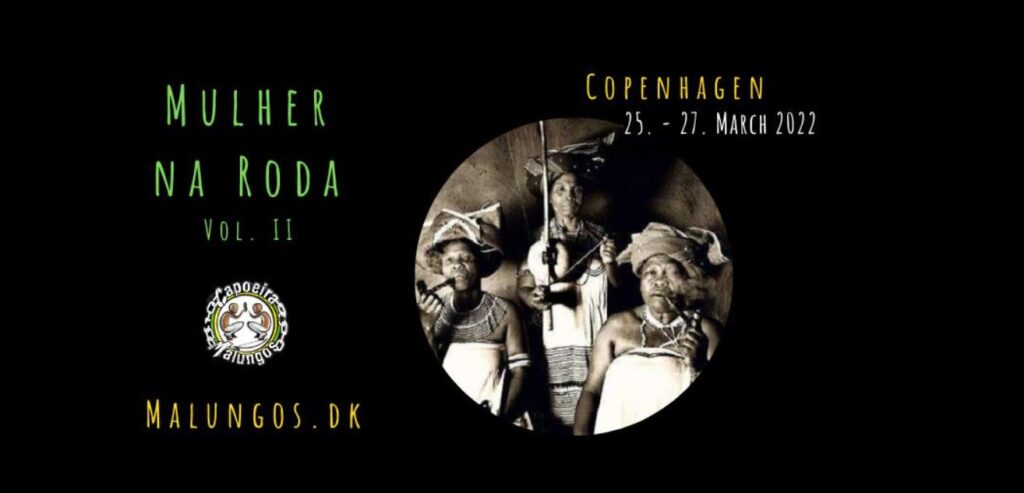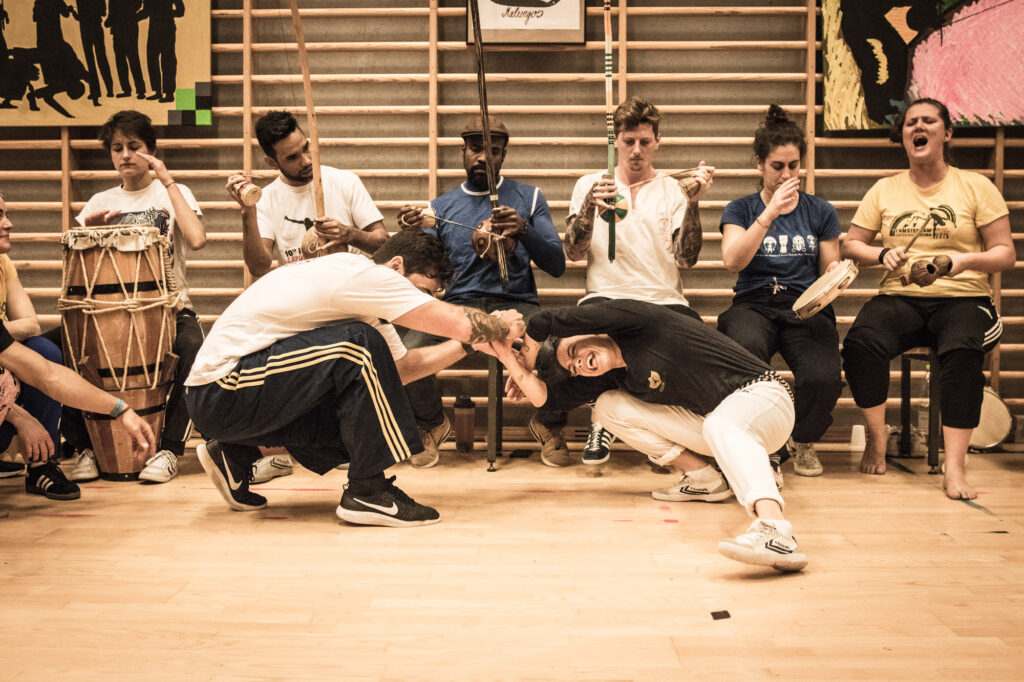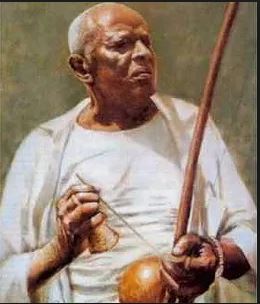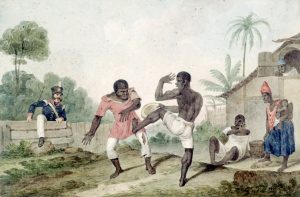
For the second time focusing on tributing, celebrating and honoring the amazing female capoeiristas in all capoeira groups around the world.
It is a 3-day festival taking place in Copenhagen Denmark that honours the role of women in Capoeira today.
Organized by Mestre Dino and Grupo Malungos Copenhagen this is the event that will set the scene for a place of expression and an opportunity for everybody to enrich their capoeira style regardless of whether you are a male or female capoeirista.
We believe it is important to constantly evolve, develop and discover new talent, but also consolidate our long-time friendships in capoeira.
This year we are therefore pleased to welcome the following to give classes:
Mestra Maria Pandeiro (Grupo Dandara)
Mestre Requeijão (Grupo Biriba Brasil)
Contra Mestra Jana (Grupo Meu Cazuá Capoeira)
Contra Mestra Mel (Ngoma Capoeira Angola)
Contra Mestra Vida (Grupo Senzala)
Contra Mestre Igor (Grupo Malungos)
Professora Faisca (Grupo Biriba Brasil)
Professora Pressinha (Grupo Capoeira Brasil)
and more to confirm
Schedule and Place:
Friday 25/3/22
17:00 – 18:00 Registration
18:00-20:00 Capoeira two levels
20:00-21:30 Open Roda
21:30 – 00:00 Dining, music and chill out
Place: TBA
Saturday 26. March
10:30-11:00 Registration
11:00-15:00 Capoeira all levels
13:30-16.30 Kids Training
14:00-15:00 Capoeira try out training free
15:00-17:00 Capoeira all levels
Place : TBA
Sunday 27. March
12:00-15:00 Capoeira all levels & dance
15:00-16:30 Training all levels and Roda
16:30-17:00 Good bye Roda
Place: TBA
Special prices for early birds (with subscription until 1st March)
All Days 650 kr. (86€)
Friday 200 kr. (26€)
Saturday 400 kr. (46€)
Sunday 300 kr.(40€)
Want to know more about the history of women in capoeira?
Read below the article that talks about what influence women have had in capoeira and in society in this context.
“Capoeira is freedom, expression, creation, improvisation. It’s a song, a dance, a martial art, a philosophy for survival. It embodies respect, dignity, and grace as a conversation, a ritual, a tradition, and a savior. “Zum zum zum, capoeira salva um”
(Zum zum zum, capoeira saves).
Women from all walks of life have long been fighting for their rights. Whether it’s the right to vote or the right to choose, women are demanding that their voices be heard. In ancient societies, women were the healers and the doctors, well-versed in natural remedies and delivering babies. There were women warriors and women military leaders who held a respected role in society, employing both masculine hardness and feminine charm.
With the scientific revolution and industrialization of religion, men viewed women a lot less as fighters and much more as an inferior gender belonging at home. However, during aproximately the past forty years, women have worked hard to eradicate the ‘shadow of a man’ image and they have gained independence in what they do, who they are, and what they can become.
Capoeiristas! (practitioners of capoeira)

The history: Capoeira is born
The history of capoeira is vital to an analysis of women and their involvement in its international growth. From 1538 to 1888, millions of Africans were brutally torn from their families and friends and relocated by the Portuguese to Brazil. These slaves were bought, baptized, branded with irons, whipped, shipped and sold. The Portuguese separated members of the same tribe in an attempt to erase their heritage, language and culture.
Due to inhumane living and working conditions, the slaves proved profitable and expendable, usually dying within three years of their purchase.While enslaved men worked outside, women remained inside and suffered a different flavor of persecution. Masters frequently brought their female property into their homes to labor as servants and fulfill them sexually.
In the senzalas, or slave quarters on the plantations, the slaves strove to use their diverse African roots and power to break out of their chains. Slaves did not necessarily speak a common language, yet they shared their passionate struggle for freedom. They fought roughly, physically preparing themselves to flee and regain their humanity. When an owner passed to inspect his human merchandise, the slaves would quickly switch to an innocent samba dance to disguise their intent.
All slaves realized that in order to escape, they needed to gather strength and unite. In the early 1600’s, a group of slaves did just that. They revolted against their masters and ran deep into the wilderness where they formed quilombos, fortified village communities that embodied the highest ideals of resistance. In the quilombos, they fought capoeira: an improvisational martial art with circular dance-like movements “played” by two opponents surrounded by people singing and playing music in a circle, or roda. [It was referred to as “fighting capoeira” up until the 20th century when it became referred to as “playing capoeira,” and still is today.
Through capoeira, the slaves developed lightning quick reflexes and an astute ability to foresee their attacker’s next move. Every member of the community needed agility to defend the quilombos, both women and men, thus they all trained and fought capoeira. Being strong wasn’t an option, Mestre Boa Gente confirms, it was “a necessity for survival.”
Brazilian authorities outlawed slavery in 1888 and shortly thereafter capoeira as well. In an attempt to cleanse away their bloody past, the government destroyed nearly all official documents regarding slavery. Ex-slaves moved from the countryside to the city for opportunities but were overwhelmed with unemployment. They formed gangs to survive, arming themselves with razorblades and capoeira. It was deadly and countless capoeiristas were caught by the police and sent to jail for their involvement. During this period, women stayed away from capoeira. The men fought out on the streets while the women presumably remained indoors, raising children and tending the home.
Mestres (masters of capoeira) carried on the traditions of their beloved art.
“The mentality of the mestres of that era was to teach capoeira to anyone who wished to learn. However, society greatly discriminated against women who wished to fight capoeira, pressuring them not to participate in any activity with risks and calling them lesbians if they did,”
source: Contra-Mestre Jô of Grupo Capoeira Brasil in New York.
Capoeira was not illegal for long because of one legendary man with a vision.

Mestre Bimba
Mestre Bimba
Mestre Bimba was born a free man in 1899 to a capoeirista father, Bimba. He dedicated his life to preserving capoeira. Back in the 1930’s, he convinced the fascist government, led by Vargas, that capoeira was Brazil’s national heritage, worthy of being honored as such. Mestre Bimba stressed the Brazilian, rather than African, roots of capoeira. As an ardent nationalist, Vargas realized that capoeira was unique to Brazil’s national identity and legalized its practice only in an academy setting.
So Mestre Bimba opened the first formal capoeira academy in Salvador da Bahia, teaching capoeira to both the poor and rich, including women who could again return to the game. He introduced formal sequences and very strict academy rules: don’t smoke, practice the fundamentals daily, avoid conversation during training and keep your body relaxed.
“I believe that Mestre Bimba was delighted to see good capoeiristas, women as much as men, learning the art that he created and developed,”
“The pride of the leaders of capoeira today is still that; teaching capoeira of body, soul and heart.”
The present: Women in the roda
Brazil may have started accepting women in capoeira later than other countries due to the local associations of capoeira with revolution, power struggles, and machismo.
“In Brazil, they said that capoeira was made for men, not for women, and that the women’s place was in the kitchen,” confesses Jô, originally from Juazeiro, Bahia, Brazil. “I was the only woman in my capoeira class so my mom didn’t want me to go. With much insistence, I managed to keep going. Things have changed a lot today”.
Naturally, capoeira has surged in popularity, among both women and men. “Capoeira é pra homem, menina, e mulher” (Capoeira is for men, children, and women — a quote from the great Mestre Pastinha). People begin training at all different ages, including Mamãe, who recently began classes in her sixties and Jô, who began capoeira at eight-years-old. “There is hope for everyone in capoeira, for any body type!” exclaimed Mestra Suelly, the first mestra (female capoeira master) in America, of Capoeira Arts in Berkeley. “Everyone must find their own game”.
There are more high-ranking female role models in capoeira now than ever before. The core ranks in capoeira are Aluno, Instrutor, Professor, Contra-Mestre, and Mestre. At a recent Capoeira Batuque batizado (baptizing ceremony where students’ progress is acknowledged and colored belts are awarded), mestres from Brazil, the United States, Australia, and Japan attested to having a 50/50 split of female to male students in their academies. However, the figures are different when you look at the upper level students.
“It’s more rare for a woman to receive a higher rank,” explains Professora Marrom of Grupo Mandinga San Diego. “Women are always fighting for their rights. I see it all the time.” Jô has avoided gender-based criticism from her mestres stating: “I give the same sweat, love, and value as they do to capoeira. One must have patience, discipline and a strong foundation [to achieve a high rank].”
“Women bleed for capoeira, and I’m not talking menstruation here, I’m talking about heart and soul, sweat, guts and energy, sometimes more than men, and are hardly recognized for their dedication and love of the game and tradition!” – Professora Marrom.
The future: Sweat, play, respect, unite
“Less women stick with capoeira at the higher levels. Why?”, asks Professor Girafa of Capoeira Batuque. Is it because men are inherently better capoeiristas? According to the four female capoeiristas interviewed, the answer is a resounding “No.” Marrom explains that men are “more overpowering when it comes down to strength, not skill, but strength. Capoeira is based on the strength of each character.” Though some women may have less upper body strength than men, “it really depends on the person,” declares Suelly.
It’s natural to feel less capable than a man due to his body mass alone, but in the dialog between two people in the roda, women can excel if they are brave, bold, and assertive. Although, Jô admits: “I feel more confident and at ease when I play capoeira with a man. I think it’s because that’s how I grew up, amongst men. Women just need more self-confidence and an equal dedication as men. Whenever women encounter a challenging new move, they must dedicate themselves even more to remove the roadblock ahead”. And they do.
But it is true that many factors can interfere with a woman’s training in capoeira. “It happens when I get sick or have an overload of work, but it’s very rare for me to take a break from capoeira,” Marrom reveals. “It has to be something really, really, really important. Capoeira is something that I take very seriously and love with a passion”.
The capoeirist and DJ Renata Potira
In addition to everyday distractions, women tend to take up capoeira in their twenties, often starting their own families soon thereafter. Giving birth can sometimes halt a woman’s capoeira training forever. But it doesn’t have to. Jô recently gave birth, having played capoeira up until two weeks prior. And she’s back in the studio teaching after just one month! With immense dedication, women capoeiristas can prioritize their lives to keep up a regular practice.
Although women bring their own flavor and vibrant feminine energy to capoeira, they can be too competitive and intense, discarding the playful element of the game. “I find women tend to lose their control and get emotional,” Marrom notes. “When they get emotional in the roda, they don’t perform. It becomes: I can’t lose”. In other words, women often get too serious, feeling they have something to prove. But this doesn’t help in the roda. Jô expresses that “when the competition between women diminishes, women will be more united”.
Respecting the Capoeira music, songs and history to write the future
That includes respecting capoeira music, an intrinsic element to any game of capoeira. A ladainha, or litany, is sung to honor the past mestres of capoeira and is accompanied by a single berimbau (bow-shaped instrument with a gourd attached for resonance, said to have originated in Africa). After the ladainha is sung, two capoeiristas are signaled to enter the roda to play.
Songs continue in a call-and-response fashion while the pandeiro (Brazilian tambourine) and atabaque (conga drum) join in. Singers comment on the game, especially in situations of added excitement, danger, and/or malicia (trickery). “Capoeira music tells stories and remembers people, times, and places. It’s essential and women have a lot to contribute musically, as well, although that hasn’t really happened to such a large extend.
Sounds like a call for more women capoeiristas to lead a ladainha and pick up a pandeiro?
So what does the future hold for women in capoeira?
Some are optimistic. “The future of capoeira for women is looking bright with room for growth and development, not only for women but for men’s development too… with more acceptance and integrity,” predicts Marrom. “Women will continue to grow a lot and to become more integrated in capoeira” Suelly adds.
“Women must not forget to be women. Play as a woman and remember to be feminine because that’s what’s makes the women in capoeira really beautiful. We’re not big old lugs; we’re not men. We are strong AND feminine.
” Iê viva a mulher na capoeira, camará!
Long live women in capoeira, my friend!
inspiration from source article : soulbrasil.com/women-in-capoeira-express-yourself-and-be-strong




